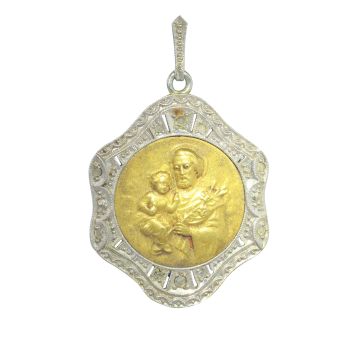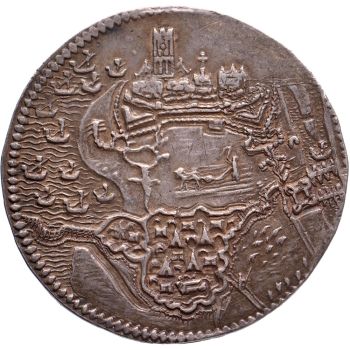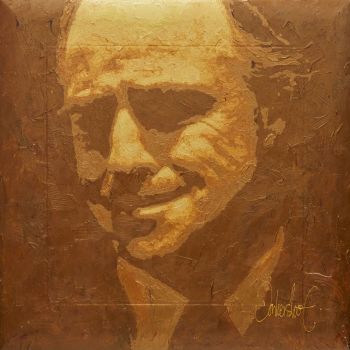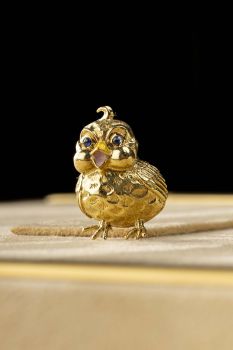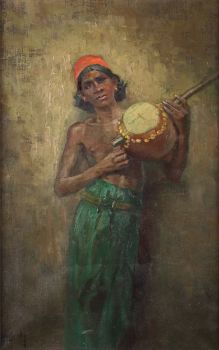UNA COPA JAPONESA PEQUEÑA PARA CRISOL SAWASA 'EN FORMA DE MELOCOTÓN' early 18th
Artista Desconocido
Precio a consultar
Zebregs & Röell - Fine Art - Antiques
- Sobre la obra de arteA JAPANESE SMALL SAWASA 'PEACH-FORM' CRUCIBLE CUP
Edo period, early 18th century
With a gilt foot-ring and inside, with a handle to one side of the cup in the form of a leafy branch with prunus flowers, extending along the sides of the cup, ending in two leaves at the opposite end of the cup with a small rose on the rim, with a cartouche to each side with gilt floral sprays in high-relief, as well as a round cartouche with flower decoration.
H. 4.7 x W. 7.5 cm
Note:
For a Sawasa cup with saucer see Uit Verre Streken, November 2018, item 51.
For further reading see the exhibition catalogue, Japanese export art in black and gold, 1650-1800, Rijksmuseum Amsterdam, 1999.
Sawasa ware is a particular group of black lacquered and gilt artifacts, produced initially in Japan/Nagasaki and later perhaps also in China and Indochina. These wares are characterized by their European shapes and Asian/Chinese decorative motives. From the late 17th till the late 18th century, the Dutch VOC, but more so private merchants, used the Dutch trade base, Deshima in Nagasaki, to order precious Sawasa ware for the rich Eurasian elite in the VOC headquarters in Batavia but also to satisfy the taste for exotic rarities in Europe. With the collapse of the VOC, the occupation of the Netherlands by the French armies and of the Dutch East Indies by the English at the end of the 18th century, the production of Sawasa ware came to a sudden end. - Sobre el artista
Puede suceder que un artista o creador sea desconocido.
Algunas obras no deben determinarse por quién está hecho o por (un grupo de) artesanos. Algunos ejemplos son estatuas de la Antigüedad, muebles, espejos o firmas que no son claras o legibles, pero también algunas obras no están firmadas en absoluto.
También puedes encontrar la siguiente descripción:
•"Atribuido a …." En su opinión, probablemente una obra del artista, al menos en parte.
•“Estudio de….” o “Taller de” En su opinión, una obra ejecutada en el estudio o taller del artista, posiblemente bajo su supervisión
•“Círculo de…” En su opinión, una obra del período del artista que muestra su influencia, estrechamente asociado con el artista pero no necesariamente su alumno.
•"Estilo de …." o “Seguidor de…”. En su opinión, una obra ejecutada al estilo del artista pero no necesariamente por un alumno; puede ser contemporáneo o casi contemporáneo
•"Manera de …." En su opinión una obra al estilo del artista pero de fecha posterior
•"Después …." En su opinión, una copia (de cualquier fecha) de una obra del artista
•“Firmado…”, “Fechado…” o “Inscrito” En su opinión, la obra ha sido firmada/fechada/inscrita por el artista. La adición de un signo de interrogación indica un elemento de duda.
•“Con firma…”, “Con fecha…”, “Con inscripción…” o “Lleva firma/fecha/inscripción” en su opinión la firma/fecha/inscripción ha sido añadida por alguien que no es el artista
¿Está interesado en comprar esta obra de arte?
Artwork details
Related artworks
Artista Desconocido
A Surinam-themed Amsterdam long-case clock1746 - 1756
Precio a consultarZebregs & Röell - Fine Art - Antiques
 curada por
curada porGallerease Magazine
1 - 4 / 12Artista Desconocido
UN NETSUKE DE MARFIL DE UN HOLANDÉS CON UNA COCKEREL18th century
Precio a consultarZebregs & Röell - Fine Art - Antiques
Artista Desconocido
The Stamford Raffles Secretaires.1800 - 1813
Precio a consultarZebregs & Röell - Fine Art - Antiques
Artista Desconocido
A rare Japanese export lacquer medical instrument box1650 - 1700
Precio a consultarZebregs & Röell - Fine Art - Antiques
Artista Desconocido
UN NETSUKE MARINE MARFIL DE UN HOLANDÉS CON UN VENTILADOR CHINO18th century
Precio a consultarZebregs & Röell - Fine Art - Antiques
Artista Desconocido
UN RARO TELESCOPIO DE CUERO LACADO JAPONÉS GRANDE1750 - 1800
Precio a consultarZebregs & Röell - Fine Art - Antiques
Artista Desconocido
UN PEQUEÑO NETSUKE DE MARFIL DE UN HOLANDÉS CON UN TAMBOR1750 - 1800
Precio a consultarZebregs & Röell - Fine Art - Antiques
1 - 4 / 21Artista Desconocido
A Dutch colonial Indonesian betel box with gold mounts1750 - 1800
Precio a consultarZebregs & Röell - Fine Art - Antiques
HUGO VILFRED VON PEDERSEN
Gadesanger fra Singapore (Musician from Singapore)1870 - 1959
Precio a consultarZebregs & Röell - Fine Art - Antiques
Dutch School
Llegada de un holandés de las Indias Orientales a Table Bay18th century
Precio a consultarZebregs & Röell - Fine Art - Antiques
 curada por
curada porDanny Bree
Artista Desconocido
The bell of the VOC fortress in Jaffna, Sri Lanka1747
Precio a consultarZebregs & Röell - Fine Art - Antiques
 curada por
curada porDanny Bree
Engelbert Kaempfer
LIBRO DE ENGELBERT KAEMPFER1651 - 1716
Precio a consultarZebregs & Röell - Fine Art - Antiques
1 - 4 / 12





